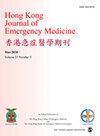Mechanical ventilation management and airway pressure release ventilation practice in acute respiratory distress syndrome: A cross‐sectional survey of intensive care unit clinicians in mainland China
IF 0.8
4区 医学
Q4 EMERGENCY MEDICINE
引用次数: 0
Abstract
Airway pressure release ventilation (APRV) has become increasingly popular for the management of acute respiratory distress syndrome (ARDS); however, its clinical impact remains a topic of debate. Furthermore, there is a gap between the guidelines and the actual clinical practices in mechanical ventilation management for ARDS. This survey aimed to explore the utilization of APRV and mechanical ventilation strategies for ARDS in Chinese intensive care unit (ICU) clinicians.A comprehensive 34‐item survey was distributed online platforms amongst ICU clinicians across mainland China from June to August 2019.A total of 420 valid responses were collected, with 57.4% (241) originating from academic hospitals and 42.6% (179) from non‐academic hospitals. Of the respondents, 98.6% (414) recognized the significance of low tidal volume ventilation for ARDS prognosis, 85.2% adhered to a tidal volume below 8 mL/kg predicted body weight, and most (46.4%) selected the initial positive end‐expiratory pressure within the range of 5–10 cmH2O based on experience. Among the respondents, 62.1% (261) reported familiarity with APRV and 41.9% (176) had implemented APRV. Of those who had utilized APRV, 93.2% (164) believed in its effectiveness for ARDS patients and 69.3% (122) advocated for early application of APRV. Substantial variations were noted regarding APRV initiation settings and the preservation of spontaneous breathing during APRV. Academic hospitals exhibited higher usage rates of lung recruitment, neuromuscular blockade, prone ventilation, and acquaintance with and utilization of APRV compared to non‐academic hospitals (all p values ≤ 0.001).Our findings highlight opportunities for improvement in mechanical ventilation management for ARDS, particularly in non‐academic hospitals. Additionally, a significant proportion of clinicians demonstrated limited knowledge of APRV, and there was a lack of consensus on its application. Further training and larger‐scale clinical trials are required to validate the efficacy and utilization of APRV in managing ARDS.急性呼吸窘迫综合征的机械通气管理和气道压力释放通气实践:中国大陆重症监护室临床医生横断面调查
气道压力释放通气(APRV)在急性呼吸窘迫综合征(ARDS)的治疗中越来越受欢迎,但其临床影响仍是一个争论的话题。此外,ARDS 机械通气管理指南与实际临床实践之间也存在差距。本调查旨在探讨中国重症监护病房(ICU)临床医生对APRV和ARDS机械通气策略的使用情况。2019年6月至8月,我们在中国大陆地区的ICU临床医生中发放了一份包含34个项目的综合调查问卷,共收集到420份有效回复,其中57.4%(241份)来自学术医院,42.6%(179份)来自非学术医院。受访者中,98.6%(414 人)认识到低潮气量通气对 ARDS 预后的意义,85.2%坚持潮气量低于 8 mL/kg 预测体重,大多数(46.4%)根据经验选择初始呼气末正压在 5-10 cmH2O 范围内。在受访者中,62.1%(261 人)表示熟悉 APRV,41.9%(176 人)曾使用过 APRV。在使用过 APRV 的受访者中,93.2%(164 人)相信 APRV 对 ARDS 患者有效,69.3%(122 人)主张尽早使用 APRV。在 APRV 启动设置和 APRV 期间保留自主呼吸方面存在巨大差异。与非学术性医院相比,学术性医院在肺募集、神经肌肉阻滞、俯卧位通气以及熟悉和使用 APRV 方面的使用率更高(所有 p 值均≤ 0.001)。此外,相当一部分临床医生对 APRV 的了解有限,对其应用缺乏共识。需要进一步的培训和更大规模的临床试验来验证 APRV 在管理 ARDS 中的有效性和应用。
本文章由计算机程序翻译,如有差异,请以英文原文为准。
求助全文
约1分钟内获得全文
求助全文
来源期刊

Hong Kong Journal of Emergency Medicine
EMERGENCY MEDICINE-
CiteScore
1.50
自引率
16.70%
发文量
26
审稿时长
6-12 weeks
期刊介绍:
The Hong Kong Journal of Emergency Medicine is a peer-reviewed, open access journal which focusses on all aspects of clinical practice and emergency medicine research in the hospital and pre-hospital setting.
文献相关原料
| 公司名称 | 产品信息 | 采购帮参考价格 |
|---|
 求助内容:
求助内容: 应助结果提醒方式:
应助结果提醒方式:


